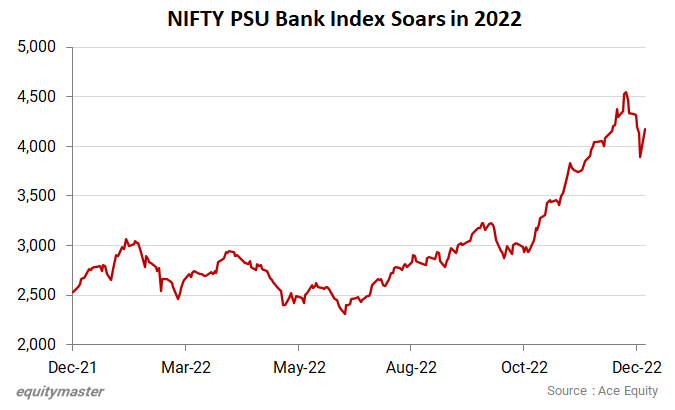India's Third Giant Leap
This Could be One of the Biggest Opportunities for Investors
- Home
- Views On News
- Dec 26, 2022 - Why PSU Banks are Falling
Why PSU Banks are Falling

Indian share markets lost ground over the last month as a surge in Covid-19 cases around the globe spooked investors.
The BSE Sensex fell by 3.1% while the Nifty fell by 3%.
Besides a spurt in Covid cases in China & Japan, better-than-expected US GDP numbers for Q3 further raised concerns that the Fed will go for more rate hikes to tame inflation, which further accentuated selling pressure in the markets.
Among the sectors that saw maximum selling were PSU Banks, metals, oil & gas, and real estate.
PSU banks have been rallying for the last few months, on the back of an improvement in financials. They are now growing faster than their peers and are fiercely competing with their private sector counterparts.
However, valuations are now steep and higher than normal. Therefore, any correction in the overall market results in a similar correction in the sector.
As a result, the Nifty PSU Bank index is down by 3.2% over the last five days, compared to a 1% decline in the Sensex.
Does this mean that the rally in PSU Banks over?
In 2022, while there were broad-based gains in the banking pack, it was public sector banks that stole the show. State-owned banks gave investors the best returns in a decade.
For the September 2022 quarter, most PSU banks reported stellar earnings coupled with improvements in asset quality and rising credit growth numbers.
State Bank of India (SBI) reported a 74% YoY rise in net profit, while Bank of Baroda (BoB) posted a 59% YoY growth in net profit.
Besides, they also reported healthy net interest margins as rising deposit rate hikes were passed on with a lag and an improvement in asset quality.
With the government's capital expenditure programs to boost demand, there is a clear thrust towards reviving capital spending in infrastructure.
In the Union Budget for this year, Finance Minister Nirmala Sitharaman announced a capital expenditure target of Rs 7.5 tn for financial year 2023, up from Rs 5.6 tn announced in financial year 2022.
This bodes well for the credit demand in the country over the near-term, putting the banking in a sweet spot.
If the government manages to walk the talk, the well-capitalised PSU lenders can continue with their journey on the fast track to growth.
How PSU Banks have performed lately
The Nifty PSU Bank index, an index that represents the performance of PSU banks has been one of the top performing indices of 2022.It has gained around 68% in the last six months and over 60% in 2022.
In fact, the index was up more than 6% on 26 December 2022.
However, it has witnessed a few lows due to overall correction in the market and due to higher-than-normal valuations of PSU Banks.

Equitymaster's View on PSU Banks
Here's what Tanushree Banerjee, Co-head of research at Equitymaster, wrote about PSU Banks in one of her editorials:
- PSU banks in India are all geared up to lend more.
The third quarter of 2022 saw them grow their loan book at 18% per annum, one of the highest in decades. With lots of capex coming on stream, the banks have mandate to offer the necessary capital.
Moreover, nearly 60% of the deposits are low-cost CASA (current and savings accounts). So, with bulk of rural and semi urban deposits, PSU banks, especially SBI, have a clear cost advantage over private sector peers.
So, is this the best time to switch from private sector to PSU banks?
Well, SBI and its PSU peers are currently not as much at peril as they were in 2018. And their potential to keep lending at healthy rates is real.
However, it would be foolish to assume that the government will keep perpetually bailing out the banks every few years. Or that the NPAs will be soon forgotten.
You can read her entire editorial here: Is it time to Switch from Private Banks to PSU Banks?
Investment in securities market are subject to market risks. Read all the related documents carefully before investing
Out Now
3 High Conviction Stocks
Chosen by Rahul Shah, Tanushree Banerjee and Richa Agarwal
Report Available
Details of our SEBI Research Analyst registration are mentioned on our website - www.equitymaster.comDisclaimer: This article is for information purposes only. It is not a stock recommendation and should not be treated as such. Learn more about our recommendation services here...

Ayesha Shetty is a financial writer with the StockSelect team at Equitymaster. An engineer by qualification, she uses her analytical skills to decode the latest developments in financial markets. This reflects in her well-researched and insightful articles. When she is not busy separating financial fact from fiction, she can be found reading about new trends in technology and international politics.


Equitymaster requests your view! Post a comment on "Why PSU Banks are Falling". Click here!
Comments are moderated by Equitymaster, in accordance with the Terms of Use, and may not appear
on this article until they have been reviewed and deemed appropriate for posting.
In the meantime, you may want to share this article with your friends!